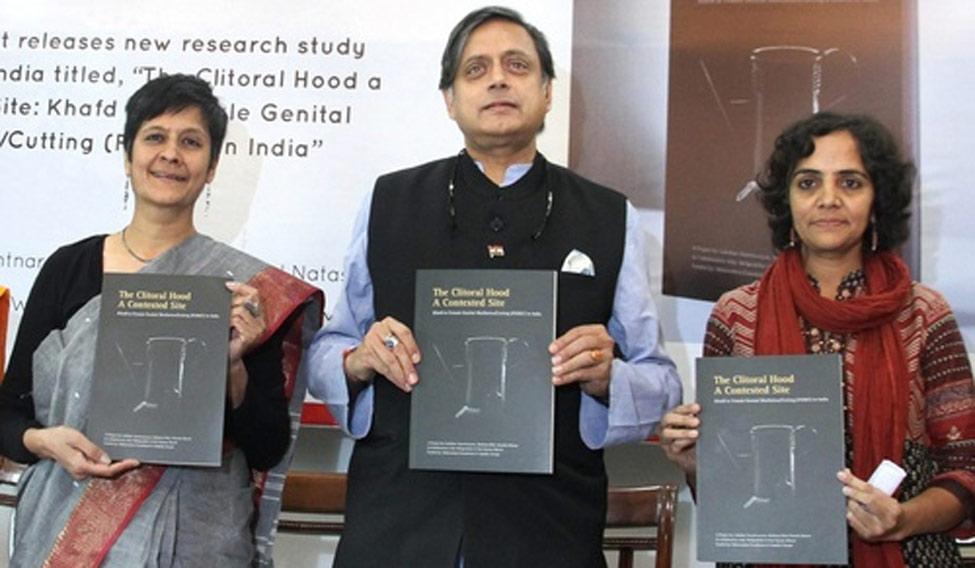A scourge like triple talaq: Female genital mutilation widespread among Bohras
PTI | New Delhi
Three out of four girls from the Bohra community in India are forced to undergo genital mutilation during their pre-teens, according to a report made public on Monday.
The findings of the study come in the backdrop of the Centre's affidavit in the Supreme Court last year, claiming that "at present, there was no official data or study (by the National Crime Records Bureau etc), which supported the existence of female genital mutilation (FGM) in India."
The Bohra community is a Shia sect of Islam and the survey has led to comparisons being drawn between FGM and triple talaq.
Congress MP Shashi Tharoor, who released the study, asked whether the government would show the same alacrity that it did in outlawing the practice of instant divorce.
"The government has found triple talaq a very easy issue to plug; on this one, will they show the same enthusiasm it remains to be seen? But I do believe we are talking of human rights and not of a particular community," Tharoor said.
The activist leading the campaign and the founder of WeSpeakOut, Masooma Ranalvi, remarked in the same vein, "This (Modi) government has been deeply interested in issues of the Muslim women. We are also Muslim women. Why have our pleas not been heard?"
According to the World Health Organization (WHO), FGM comprises "all procedures that involve the altering or injuring of female genitalia for non-medical purposes and is recognised internationally as a violation of the human rights of girls and women."
The study also points out that in the absence of a law, India could become a global hub for FGM, as many countries such as the US and Australia have seen arrests and convictions for carrying out the practise.
The report titled The Clitoral Hood a Contested Site: Khafd or Female Genital Mutilation in India was released at an event in New Delhi.
It has been prepared jointly by a survivors' collective called WeSpeakOut and Nari Samta Manch and authored by independent researchers Lakshmi Anantnarayan and Shabana Diler.
The study included responses from 94 participants, of which 83 were women survivors of FGM and 11 were men.
The women surveyed were aged between 17 and 89 years. All the interviewees together had 81 daughters, of which six were too young, 55 were subjected to 'khafd' and 20 were not.
This indicated that nearly 75 per cent of the daughters underwent FGM, the study pointed out.
Further, these women cumulatively knew 1,248 women within their families who had undergone "khafd", i.e., each participant knew approximately 14 women in their family.
The study also included testimonies of survivors of FGM as well as traditional circumcisers.
One such cutter has been quoted in the report as saying that she has performed 6,000 'khafd' in 20 years of her practice and another confessed to cutting 4,800 to 6,000 girls over 50 years.
Often forceps, scissors, scalpels and blades are used to perform FGM.
Tharoor said that the findings of the study made the government's stance on the issue in the Supreme Court that there was no evidence of the practice 'untenable'.
The survey also highlights that increasingly in urban areas, doctors in medical facilities also performed FGM. Among the respondents subjected to 'khafd', six were cut by medical doctors and 75 were cut by traditional cutters, the report said.
While supporters of the practice claim that 'khafd' was practised by the Bohras and is just 'a nick on the clitoral hood', the author of the report said in reality what was practised was much more grievous.
"Most women subjected to khafd in India undergo Type 1 FGM or clitoridectomy, which includes partial or total removal of the clitoral hood or clitoris. Very few younger women may be subjected to Type 4 FGM, which includes pricking, piercing or cauterisation," Anantnarayan, author of the report, said.
Read our cover story on FGM: The cut and the hurt and Education is the key
The survey was carried out in four Indian states with high concentration of the Bohras—Gujarat, Madhya Pradesh, Maharashtra and Rajasthan—as well as Kerala, where a few Sunni Muslim sects are known to practise FGM.
The Bohra expatriates from Canada, the United Arab Emirates and the US, as well as traditional circumcisers and healthcare professionals, were also included in the sample.
The report also warned that in the absence of a law banning the practice in India, the country was at the risk of becoming a hub for FGM for expatriate and foreign Bohra girls following a crackdown in Australia and the US.
A Bohra doctor was arrested in Michigan, the US, last year for allegedly performing female genital mutilation on two seven-year-olds.
In Australia, three people were convicted of FGM in a landmark trial in 2015.
An online petition initiated by WeSpeakOut on Change.Org seeking an end to this practice has garnered over one lakh signatures. A copy of this was presented to Women and Child Development Minister Maneka Gandhi last year.
Subsequently, the minister promised to bring a law as well as write to the Syedna, the spiritual leader of the community, asking him to enforce a ban.
However, neither of these was done and the ministry has been maintaining silence on this issue.





